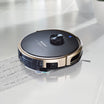What about cables and smaller objects and obstacles on the floor?
The great enemy of robotic vacuum cleaners are loose cables, especially thin ones. There is a danger that the robot will wind them on one of the rotating brushes. One solution is to set prohibited zones in the application, another option is to cover or attach the cables to the rails.
Also, be careful if you are going to dry clothes in the home, because the legs of the dryer can be a big trap for the robot, as well as armchairs, chair legs or tables that have connecting strips right next to the ground.
Water spilled on the ground can also cause a problem, as the robotic vacuum cleaner is not designed to vacuum liquids. It is necessary to pay attention to the water bowls of our pets, so as not to spill water on the floor, which the vacuum cleaner could suck in and damage its internal electronic system. We recommend marking the bowls as a prohibited zone or placing them in a safe place. If you let the vacuum cleaner also vacuum in the shower, (the so-called walk-in shower), which is already part of many modern households, make sure that there is no water left in it.













